Wenn wir versuchen, uns bei unseren eigenen WordPress-Websites anzumelden, kommt es immer wieder vor, dass die Anmeldeseite aktualisiert und umgeleitet wird, so dass wir nicht auf den WordPress-Administrationsbereich zugreifen können.
Wenn Sie dieses Problem haben, sind Sie nicht allein. Das Problem des Aktualisierens und Weiterleitens der WordPress-Anmeldeseite ist weit verbreitet und frustriert viele WordPress-Site-Besitzer. Dennoch haben wir mehrere bewährte Methoden zur Lösung des Problems getestet.
In dieser umfassenden Anleitung zeigen wir Ihnen, wie Sie das Problem mit der Aktualisierung und Weiterleitung der WordPress-Anmeldeseite beheben können. Tauchen wir ein und bringen Sie zurück in Ihr WordPress-Dashboard, damit Sie die Kontrolle über Ihre Website zurückgewinnen können!
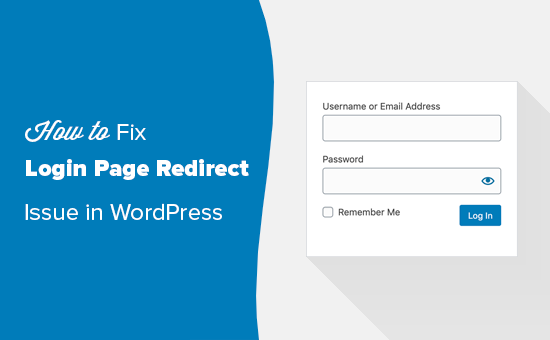
Was verursacht die Login-Seite aktualisieren und Redirect Problem in WordPress?
Der Fehler beim Aktualisieren der WordPress-Anmeldeseite und bei der Weiterleitung (auch WordPress-Login-Weiterleitungsschleife genannt) wird in der Regel durch falsche WordPress-URL-Einstellungen oder das Versäumnis, Login-Cookies zu setzen, verursacht.
Wenn Sie sich anmelden, überprüft WordPress normalerweise Ihren Benutzernamen und Ihr Passwort und setzt dann ein Anmelde-Cookie in Ihrem Browser. Danach leitet es Sie zum WordPress-Dashboard weiter.
Wenn WordPress das Login-Cookie nicht korrekt setzt oder die URL des WordPress-Administrationsbereichs nicht korrekt ist, werden Sie zurück zum Login-Bildschirm anstatt zum Admin-Dashboard geleitet.
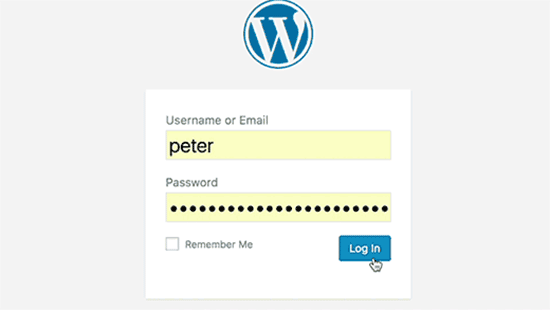
Login-Probleme können auch durch verschiedene WordPress-Fehler verursacht werden, wie z. B. den Fehler beim Aufbau der Datenbankverbindung, einen internen Serverfehler oder den weißen Bildschirm des Todes.
In diesem Sinne, lassen Sie uns das Problem der Umleitung und Aktualisierung der WordPress-Anmeldeseite suchen und beheben. Sie können diese schnellen Links verwenden, um zu einer bestimmten Methode zu springen:
- Method 1: Clear Cookies to Resolve Login Issues
- Method 2: Update WordPress URL Settings
- Method 3: Delete .htaccess File in WordPress
- Method 4: Deactivate Your Plugins
- Method 5: Revert Back to the Default Theme
- Method 6: Reinstall WordPress Core
- Video Tutorial
- What to Do If You Can't Fix WordPress Login Redirect Issue
Hinweis: Wenn Sie die fortgeschrittenen Schritte in diesem WordPress-Tutorial ausprobieren möchten, erstellen Sie bitte zunächst ein Backup Ihrer Website. Siehe unsere Anleitung zur manuellen Erstellung eines WordPress-Datenbank-Backups.
Methode 1: Cookies löschen, um Login-Probleme zu beheben
WordPress verwendet Cookies für die Anmeldeauthentifizierung. Daher ist der erste Schritt bei der Behebung von Problemen mit der WordPress-Anmeldung der einfachste. Sie müssen die Cookies und den Cache Ihres Browsers löschen.
Klicken Sie in Google Chrome einfach auf das Menü „Browsereinstellungen“ und wählen Sie dann „Weitere Tools“ „Browserdaten löschen„.
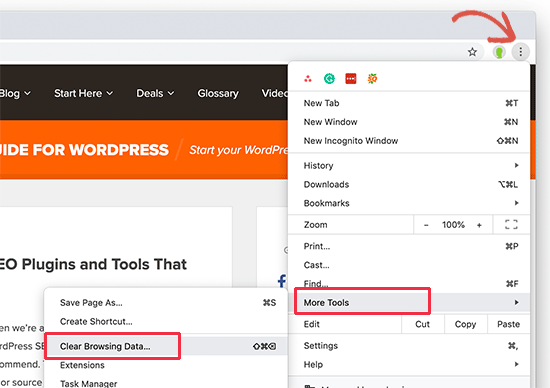
Dadurch wird die Chrome-Einstellungsseite mit einem Popup-Fenster „Browsing-Daten löschen“ auf dem Bildschirm angezeigt.
Hier müssen Sie die Optionen „Cookies und andere Websitedaten löschen“ und „Bilder und Dateien im Cache“ auswählen.
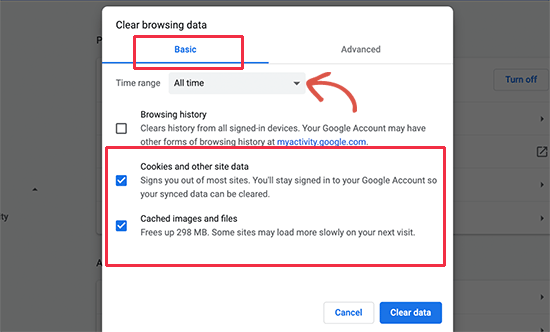
Klicken Sie anschließend auf die Schaltfläche „Daten löschen“, damit Google Chrome den Browser-Cache löscht.
Stellen Sie außerdem sicher, dass in Ihrem Browser Cookies aktiviert sind. Starten Sie danach Ihren Browser neu und versuchen Sie dann, sich anzumelden. Damit sollte das Problem für die meisten Leute behoben sein.
Wir haben eine vollständige Anleitung mit Screenshots, die zeigt, wie man den Cache und die Cookies in allen gängigen Browsern löscht.
Methode 2: WordPress-URL-Einstellungen aktualisieren
WordPress wird mit Einstellungen für die URL Ihrer Website und die URL Ihrer WordPress-Installation geliefert.
Wenn Sie Zugang zu Ihrem WordPress-Administrationsbereich hatten, konnten Sie diese Option auf der Seite Einstellungen “ Allgemein sehen.
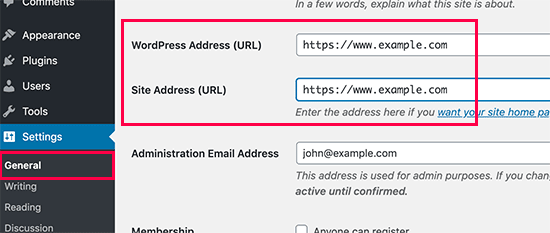
Wenn diese URLs nicht korrekt sind, leitet WordPress Sie zurück auf die Anmeldeseite um.
Da Sie keinen Zugriff auf den WordPress-Administrationsbereich haben, müssen Sie die Datei wp-config.php bearbeiten, um dieses Problem zu beheben.
Die Datei wp-config.php ist eine spezielle Datei in WordPress, die Ihre wichtigen WordPress-Einstellungen enthält. Sie können mit einem FTP-Client oder über die Dateimanager-App in Ihrem WordPress-Hosting-Konto-Dashboard darauf zugreifen.
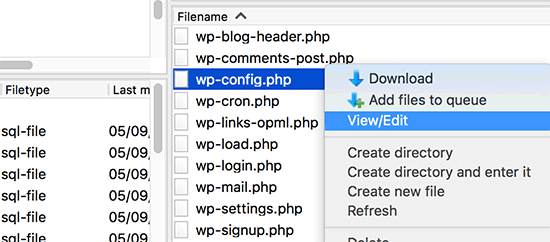
Sie finden die Datei wp-config.php im Stammverzeichnis Ihrer Website. Bearbeiten Sie einfach die Datei und fügen Sie die folgenden Codezeilen ein, direkt vor der Zeile "That's all, stop editing! Viel Spaß beim Veröffentlichen".
define('WP_HOME','https://www.example.com');
define('WP_SITEURL','https://www.example.com');
Vergessen Sie nicht, „example.com“ durch Ihren eigenen Domänennamen zu ersetzen.
Danach speichern Sie Ihre Änderungen und laden die Datei wieder auf Ihre Website hoch.
Sie können nun Ihre WordPress-Website besuchen und versuchen, sich anzumelden. Hoffentlich ist das Problem damit für Sie behoben. Sollte dies nicht der Fall sein, lesen Sie weiter, um weitere Schritte zur Fehlerbehebung zu erfahren.
Methode 3: Löschen der .htaccess-Datei in WordPress
Manchmal kann die .htaccess-Datei beschädigt werden, was zu internen Serverfehlern oder einem Fehler bei der Aktualisierung der Anmeldeseite führen kann.
Greifen Sie einfach mit einem FTP-Client oder über die Dateimanager-App im Dashboard Ihres Hosting-Providers auf Ihre Website zu.
Sobald die Verbindung hergestellt ist, suchen Sie die .htaccess-Datei im Stammverzeichnis Ihrer Website und laden Sie sie als Sicherungskopie auf Ihren Computer herunter.
Wenn Sie Ihre .htaccess-Datei nicht finden können, kann Ihnen dieser Leitfaden helfen , warum Ihre .htaccess-Datei fehlen könnte.
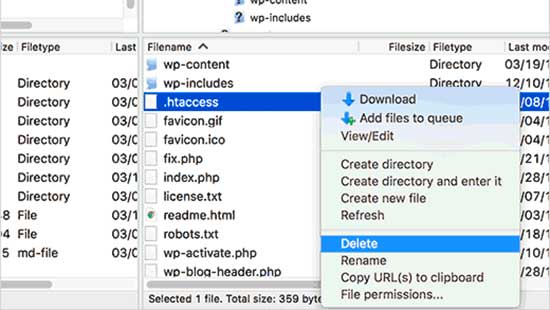
Danach löschen Sie die .htaccess-Datei von Ihrer Website.
Öffnen Sie als Nächstes das wp-admin-Verzeichnis, und wenn sich dort eine .htaccess-Datei befindet, löschen Sie auch diese.
Sie können nun versuchen, sich bei Ihrer WordPress-Website anzumelden. Wenn Sie Erfolg haben, bedeutet dies, dass Ihre .htaccess-Datei Sie daran gehindert hat, sich bei WordPress anzumelden.
Sobald Sie eingeloggt sind, gehen Sie einfach auf die Seite Einstellungen “ Permalinks im WordPress-Administrationsbereich und klicken Sie auf die Schaltfläche „Speichern“, ohne Änderungen vorzunehmen. Dadurch wird eine neue .htaccess-Datei für Ihre Website erstellt.
Methode 4: Deaktivieren Sie Ihre Plugins
Manchmal können WordPress-Plugins dieses Problem verursachen, insbesondere wenn es einen Konflikt zwischen zwei Plugins gibt.
Um alle Ihre WordPress-Plugins zu deaktivieren, verbinden Sie sich mit einem FTP-Client oder über die Dateimanager-App in Ihrem Webhosting-Konto-Dashboard mit Ihrer Website.
Sobald Sie verbunden sind, gehen Sie zum Verzeichnis /wp-content/. Darin finden Sie einen Ordner namens „plugins“. Hier installiert WordPress alle Ihre Plugins.
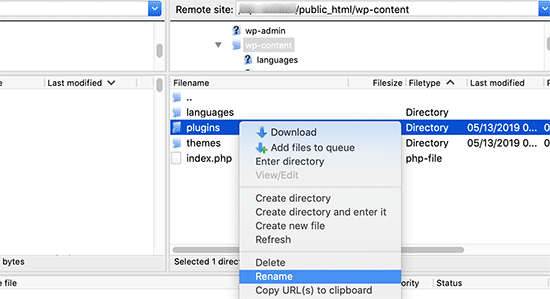
Benennen Sie einfach den Plugins-Ordner in „plugins_backup“ um. Dadurch werden alle WordPress-Plugins, die auf Ihrer Website installiert sind, deaktiviert.
Wir haben auch eine ausführliche Anleitung, wie Sie alle WordPress-Plugins deaktivieren können, wenn der WordPress-Admin nicht erreichbar ist.
Sobald Sie alle Plugins deaktiviert haben, versuchen Sie, sich bei Ihrer WordPress-Website anzumelden. Wenn Sie Erfolg haben, bedeutet dies, dass eines Ihrer Plugins das Problem verursacht hat.
Methode 5: Zum Standardthema zurückkehren
WordPress-Themes können auch nach einem Upgrade auf eine neuere Version von WordPress oder des Themes selbst Konflikte verursachen. Um herauszufinden, ob das Problem durch Ihr Theme verursacht wird, müssen Sie es deaktivieren.
Der Vorgang ist ähnlich wie bei der Deaktivierung von Plugins. Stellen Sie mit einem FTP-Client eine Verbindung zu Ihrer Website her. Gehen Sie dann zum Verzeichnis /wp-content/themes/ und benennen Sie Ihr aktuelles Theme-Verzeichnis in „themes_backup“ um.
Versuchen Sie dann, sich erneut anzumelden. Wenn Sie Erfolg haben, bedeutet dies, dass Ihr Thema das Problem verursacht hat.
Sie können nun eine neue Kopie Ihres Themes installieren, um zu sehen, ob das Problem dadurch behoben wird. Wenn das Problem erneut auftritt, müssen Sie den Support Ihres Themes kontaktieren oder zu einem anderen WordPress-Theme wechseln.
Methode 6: WordPress Core neu installieren
In seltenen Fällen kann das Problem der ständigen Aktualisierung der Anmeldeseite durch beschädigte WordPress-Kerndateien verursacht werden.
Diese Kerndateien sind die Grundlage Ihrer WordPress-Website und verwalten wichtige Funktionen. Wenn diese Dateien beschädigt oder mit falschem Code überschrieben werden, kann dies zu verschiedenen Fehlern führen, einschließlich Problemen bei der Anmeldung.
Gehen Sie zunächst zu WordPress.org und laden Sie die neueste Version der Software herunter. Nachdem Sie die Datei heruntergeladen haben, entpacken Sie sie auf Ihrem Computer. Dadurch wird ein Ordner mit dem Namen „wordpress“ erstellt, der alle erforderlichen Dateien für die Neuinstallation enthält.
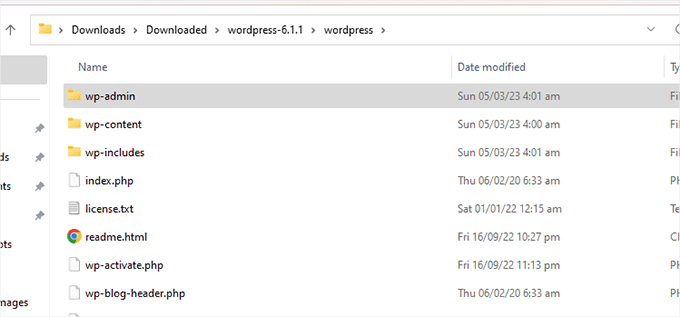
Als Nächstes müssen Sie eine Verbindung zu Ihrer Website herstellen, indem Sie einen FTP-Client oder den Dateimanager Ihres Hosts verwenden.
Sobald Sie verbunden sind, navigieren Sie zum Stammordner Ihrer Website. Dies ist das Hauptverzeichnis, das Verzeichnisse wie wp-admin, wp-content und wp-includes enthält.
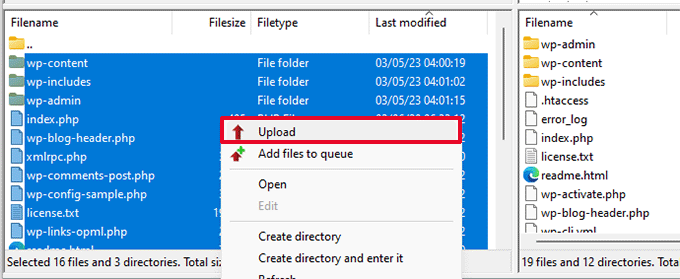
In diesem Stadium nehmen Sie alle Dateien aus dem Ordner „wordpress“ auf Ihrem Computer und laden sie in das Stammverzeichnis Ihrer Website hoch.
Ihr FTP-Client wird Sie auffordern, das Überschreiben vorhandener Kerndateien zu bestätigen.
Da Sie beschädigte WordPress-Kerndateien löschen und durch neue ersetzen, wählen Sie „Überschreiben“ und die Option „Immer diese Aktion verwenden“, damit Sie nicht jede Datei einzeln bestätigen müssen.
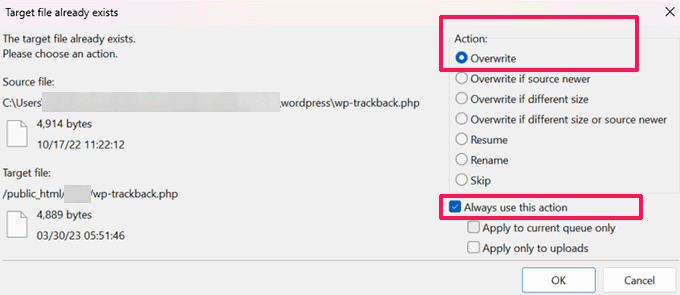
Klicken Sie abschließend auf „OK“, um den Upload-Vorgang zu starten. Ihr FTP-Client wird die WordPress-Kerndateien auf Ihrer Website durch die neuen Dateien von Ihrem Computer ersetzen.
Sobald der Upload abgeschlossen ist, besuchen Sie Ihre Website, um zu sehen, ob der Fehler behoben ist. Wenn das Problem bei der Anmeldung durch eine beschädigte Kerndatei oder Malware verursacht wurde, sollte die Fehlermeldung verschwunden sein und Sie sollten sich erfolgreich anmelden können.
Video-Anleitung
Wenn Sie eine visuelle Anleitung benötigen, sehen Sie sich bitte das folgende Video an.
Was zu tun ist, wenn Sie WordPress Login Redirect Problem nicht beheben können
Wenn Sie alles versucht haben, vom Löschen der Browser-Cookies bis zum Deaktivieren von Themes und Plugins, das Problem aber immer noch besteht, können Sie versuchen, in der WordPress-Community um Unterstützung zu bitten.
Benutzer aus Gruppen wie der WPBeginner Engage Facebook Gruppe haben vielleicht das gleiche Problem wie Sie und können Hinweise geben, was zu tun ist, um die Probleme mit der Login-Seite zu lösen.
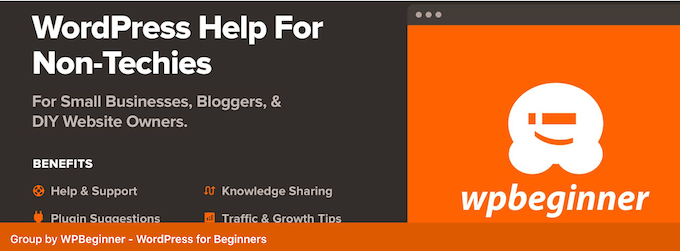
Ansonsten können Sie sich an WordPress-Support-Lösungen wie WPBeginner Pro Services wenden. Wir bieten Premium-WordPress-Support für Notfälle, bei dem Experten herausfinden können, was mit Ihrer Website passiert und die Ursache des Problems beheben.
Sie können auch unsere WordPress-Wartungsdienste in Anspruch nehmen, um zu verhindern, dass Probleme wie Malware, hohe Ausfallzeiten und veraltetes WordPress Ihre Website überhaupt beeinträchtigen.
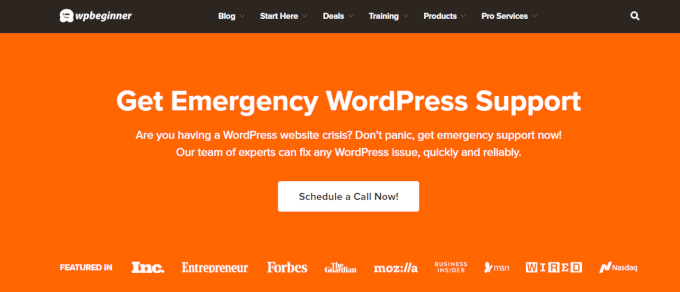
Vereinbaren Sie noch heute einen Termin mit unserem Team, um zu sehen, was wir für Ihre Website tun können.
Erfahren Sie mehr WordPress Problembehandlung Lösungen
Treten bei Ihnen andere häufige WordPress-Fehler auf und müssen Sie einen Weg finden, um sie zu beheben? Hier sind andere Artikel, die Sie sich ansehen können:
- Behebung des Fehlers „Zu viele Weiterleitungen“ in WordPress
- Wie man den Fehler „Diese Website kann nicht erreicht werden“ in WordPress einfach behebt
- So beheben Sie die Meldung „Die Website hat technische Probleme“ in WordPress
- WordPress-Beiträge mit dem Fehler 404 beheben (Schritt für Schritt)
- Wie man den Fehler „Gemischter Inhalt“ in WordPress behebt (Schritt für Schritt)
- Wie man den ungültigen JSON-Fehler in WordPress behebt (Anleitung für Anfänger)
- Wie man WordPress-Fehlerprotokolle findet und darauf zugreift (Schritt für Schritt)
- Wie WordPress nicht senden E-Mail Problem zu beheben
- Wie man WordPress im Wartungsmodus hält (Der einfache Weg)
Wir hoffen, dass dieser Artikel Ihnen geholfen hat, das Problem mit dem Aktualisieren und Weiterleiten der WordPress-Anmeldeseite zu lösen. Vielleicht möchten Sie auch unseren vollständigen WordPress-Leitfaden zur Fehlerbehebung lesen oder sich unsere Top-Tipps für die besten WordPress-Plugins und -Tools zur Erweiterung Ihrer Website ansehen.
Wenn Ihnen dieser Artikel gefallen hat, dann abonnieren Sie bitte unseren YouTube-Kanal für WordPress-Videotutorials. Sie können uns auch auf Twitter und Facebook finden.





Goxi
You safe my life man! Just messed around the login wp admin site if it wasn’t for this tutorial I would never have solved the problem!
WPBeginner Support
Glad our guide was helpful
Admin
Tomer
Thank you very much for this tutorial!
I have tried these methods and managed to temporarily fix the problem.
The thing is, that after everything seems to be working again, the next day it happens again. Without me changing anything at all. Any tips on that?
WPBeginner Support
You would want to reach out to your hosting provider to ensure there is nothing on their end that could be causing this conflict
Admin
Sulivan
For those who ended up here an after all steps could’t solve this, check if you changed table prefix. I have changed mines and just figured out that there are some usermeta that stores the old prefix.
WPBeginner Support
Thanks for sharing what was the issue on your site
Admin
shahin
thank you bro , amazing content and very useful
WPBeginner Support
Glad you like our content
Admin
Julie
Tks a lot ! You save me !
WPBeginner Support
You’re welcome, glad our guide could help
Admin
Ann
Thanks a lot to all of you, and specially to Hand: Changing back php version to 7.3 solved this for me!
WPBeginner Support
Glad the recommendations could help you
Admin
Hand
I had this issue and spent an entire day trying every possible solution mentioned here and elsewhere without any progress. Then I remembered that I had changed the PHP version from 7.3 to 7.4 on my hosting’s control panel (DirectAdmin). Changing back php version to 7.3 solved this for me.
WPBeginner Support
Thanks for sharing the solution that worked for you
Admin
Jeff
This worked for me.
Joe
I’ve just worked out that PHP 7.4 missed three of the extensions we had installed on PHP 7.3:
php74-php-opcache
php74-php-process
php74-php-soap
As soon as they were enabled and provisioned the wp-admin 404 error disappeared. Hope that helps you to upgrade to 7.4 trouble-free!
Shiv
Hi
I followed this article and in my case i found one plugin was causing this issue.So it found it by renaming each plugin and keep trying the login and once i reached this plugin and renamed it …admin login worked.So…i renamed back rest of the plugins to their original names and keep this once renamed and admin worked and later i sorted my plugin
Thanks
WPBeginner Support
Glad you were able to get your site working and thanks for sharing the method you used for other users with this issue
Admin
mark
I deleted the htaccess file as instructed, and now I can’t get a login screen at all. No access to my site (404)
WPBeginner Support
To check for the possible issues, you would want to go through the steps in our article here: https://www.wpbeginner.com/beginners-guide/beginners-guide-to-troubleshooting-wordpress-errors-step-by-step/
Admin
Di
Thanks, you’re a life saver. The .htaccess hack worked!
WPBeginner Support
Glad our recommendation could be helpful
Admin
gho
I owe you one! I used the codes and it’s simply worked. Big thanks wpbeginner!
WPBeginner Support
Glad our guide could help
Admin
Giang Nguyen
thanks man. Your Update Site URL works!
I tried to manually install piece by piece in my local macbook, to learn how wordpress work, and missing your piece!
The install manual doesn’t really have this kind of info =)
giang
WPBeginner Support
Glad our recommendation could help you
Admin
Todd
I’ve had this issue before many years ago and I think my fix was the same this time as it was then. After trying many many suggestions above, what finally did it for me was clearing my chrome browsing history. Someone mentioned trying that and not working, but this was not actually offered as a solution so I thought I would post it. Thanks!
WPBeginner Support
Thanks for sharing what worked for you
Admin
Peter
I was having a login error where my login page keeps refreshing and redirecting me back to the login screen. And for me (I tried all of the above solutions) and none of them worked.
Then I checked the error_log file on my WordPress site and saw that the problem I was having said „WordPress database error Disk full“
As a result, I went into my wp-config.php file and added the following code to file right above the text line where it says in the file „* That’s all, stop editing! Happy blogging. */“.
The code I added is:
define(‚WP_MEMORY_LIMIT‘, ‚256M‘);
Problem solved.
WPBeginner Support
Thanks for sharing the solution that worked for you
Admin
Chris
Thanks for this – it worked perfectly and tehe memory limit solved the problem. I was really angry because all other stuff like plugins, themes, .htaccess didn’t work!!!
Greetigs Chris
purushotham
i am not able to login my wordpress admin ,getting 404 error.what should i do to reslove the issue.
WPBeginner Support
For a starting point, you would want to reset your permalinks using: https://www.wpbeginner.com/wp-tutorials/how-to-fix-wordpress-posts-returning-404-error/
If that does not solve the error then you could try the troubleshooting steps in our guide here:
https://www.wpbeginner.com/beginners-guide/beginners-guide-to-troubleshooting-wordpress-errors-step-by-step/
Admin
Travis
None of these options worked for me… Turns out to be a hosting issue. Called Network Solutions and they said that because my database was over 300mb I needed to upgrade my database because after 300mb they lock you out…. Upgrading by DB fixed the issue. Who knew….?!
WPBeginner Support
Glad you were able to find the solution to the problem
Admin
Chris
How did you upgrade the WP database? I think this may be my problem.
WPBeginner Support
You would reach out to your hosting provider and they would let you know if you need more space for your database similar to Travis
Admin
hamdi
Defining these lines ON TOP OF wp-config.php helped. They don’t help if you put them at the bottom.
define(‚WP_HOME‘,’http://example.com‘);
define(‚WP_SITEURL‘,’http://example.com‘);
WPBeginner Support
It should still work if you place it at the bottom of the wp-config file, there may have been a problem with where you placed it depending on what’s in your specific wp-config file.
Admin
Joe G
Nothing worked for me until I went into ftp server and edited index.php in the site’s root (alongside all of the other wp-related files mentioned here), and set define( ‚WP_USE_THEMES‘, FALSE )
This will temporarily break your site temporarily (no error codes, just white screen), though my site loading wasn’t the problem. This allowed me to finally access my dashboard through the login site, where I then put a brand new theme on and fixed what I thought might be the culprit (I made the mistake of redirecting my „Home“ link on my menu to an exterior site).
After removing the „Home“ link, (or just to be safe, the menu in general), and creating a new menu with only the pages in question I wanted to use, I re-set the ‚wp_use_themes‘ to TRUE and we’re back off to the races again!
WPBeginner Support
Thanks for sharing what worked for you
Admin
Mohsen
I‘ ve tested all of these solutions, but my problem has not solved.
WPBeginner Support
If none of these methods worked then you may want to reach out to your hosting provider to ensure there aren’t any issues on their end.
Admin
Matt Nigro
My issue is that everyone has access to my site…no login required! Can someone help.
WPBeginner Support
Do you mean people can view your site or people can log in to your site? If you mean the login then if you’ve logged in once, WordPress should log you back in but your site’s visitors would still need to log in. If you visit your site in an incognito browser you should see what your visitors see.
Admin
Pranay Singh
I am unable to login to the wordpress admin page as it is showing too many redirects(error) as I had just installed the wordpress and since then I am unable to login the page I have made every change and have checked each possible way through which I can make changes. I have done everything but nothing works. Please help me with the issue.
WPBeginner Support
For the too many redirects error, you would want to take a look at a different article of ours located here: https://www.wpbeginner.com/wp-tutorials/how-to-fix-error-too-many-redirects-issue-in-wordpress/
Admin
Peter Guckian
For some reason, everytime I go to login into my work’s cms site it redirects me to the actual website rather than the dashboard, have deleted browsing history, cookies, cache etc but no luck. Nobody else in the office seems to have faced this difficulty before
WPBeginner Support
If you’re using the /wp-admin url to log into the site you may want to try instead using /wp-login.php to see if your browser is not fully clearing the cache.
Admin
Hugo
For me the solution was deleting user.ini file in the root of my site
This file was created by host
WPBeginner Support
Thanks for sharing this method, hopefully it helps anyone else if the above methods don’t work
Admin
Stephen Vincent Abarca
I have a problem in my login. When I visit my site with /wp-admin it then put itself to /wp-login.php with a popup login indicating „your connection to this site is not private“. I cannot login even I put my user and pass.
WPBeginner Support
WordPress should normally redirect you to that page if you have not logged in. From the error, you may need to ensure your SSL and https are set up correctly: https://www.wpbeginner.com/wp-tutorials/how-to-add-ssl-and-https-in-wordpress/
Admin
mahyar
thank you for your guide
i delete htaccess and every thing fixed
i made another one from setting and save
then i compare both backup file and new one
the backup one has some extra entries
is it ok? or i wil face problem?
WPBeginner Support
It would depend on what is in the file, you would normally lose any added settings such as: https://www.wpbeginner.com/wp-tutorials/9-most-useful-htaccess-tricks-for-wordpress/
Admin
Stefano
My issue is little different. When I click on customize theme, i get white page.
Also tried to install the default theme, but nothing changes. I noticed one thing in the url, this code %3A%2F%2F instead of // and that should be part of the problem i think…
I wanted to ask if someone had the same misadventure and how he solved it. Thanks P.S. This problem occurred to me a few months ago, but I had not given too much weight, thinking it would be resolved with a new upgrade, but unfortunately it was not …
WPBeginner Support
The %s are it encoding the symbols in the url, that would likely not be your issue. You may want to try increasing your memory limit: https://www.wpbeginner.com/wp-tutorials/fix-wordpress-memory-exhausted-error-increase-php-memory/
To see if you are running out of memory as it is loading or check with your host to see if this could be an error that they can see.
Admin
Reza Taba
Divi Builder plugin was the culprit. Disabling it resolved the issue. Then I uninstalled and reinstalled it.
FIXED.
Thanks for the help!
Marnus
None of the mentioned methods worked for me.
Resetting my password worked for me though.
And no, I did not try to log in with the wrong password.
I tested using a wrong password and the site would respond accordingly by saying it is wrong, but when using the correct password, it would just be in the login loop.
Michael Morad-McCoy
NONE of the above worked! Very, very frustrated as I need to migrate my site to a new host and doing so manually hasn’t worked so I wanted to try a plug-in. But I cannot access Network Admin to add the plugins!! Arrgh!
saurab
Hi
I tried all these steps but still i am not able to login.
Chinmay Ray
Hi, Thank You for this blog it cleared alot of my doubts. I have one query
i have access to wordpress however, when i login with email and password, i come back to the website instead of wordpress dashboard of that website. Yes am not admin. i have been given access by my client.
please help me with this.
WPBeginner Support
Hi Chinmay,
The client may have a plugin to redirect users to the homepage upon login. You may need to ask them to find and disable that plugin.
Admin
ken
once again. this site save my site.
saber.tabatabaee
my case in mysql status of admin user changed to zero 0 and just need to change it to 1
MR-wp
Hello dear admin
I’m really Thankful
my problem solved after 2 hours struggling
I am from Iran and I am very happy I visited your website.
Wim
Those 2 last lines of code helped me… A LOT!
Many thanks for this post…
Rama
i tried all this steps and field to login return me to home page is there is any another solution to fix this issue ? and thanks.
Dapo Momodu
When i disabled my plugins folder from cpanel i was able to login. So now i will look for the plugin that made it act like that
Rams
Thanks a lot. I dig my head for more than a day on this. I have to move my client’s website from our server to HostGator and I found that even if I gave valid login credentials, I can’t logs into it.
The stupid thing I did is if WordPress Address URL and Site Address URL is not same, Google Chrome can’t allow to logs in.
The problem is domain is redirected to www. Since WordPress Address URL doesn’t have www, Chrom didn’t recognize as a legit one.
Thank you so much for your effort in making this valuable article.
WPBeginner Support
Hi Rams,
Glad you found it helpful. Don’t forget to join us on Twitter for more WordPress tips and tutorials.
Admin
Emilia Wiliams
IT WORKED. Thanks!
I deleted all public, primary and sub-domain .htaccess though.
Then saved permalinks and all was good.
Paul de Jong
Hi,
None of that worked, but using this did:
define (‚RELOCATE‘, true);
Thanks.
Luke
Hello Paul,
Where did you put that code?
in the wp-config file?
Manas Dattagupta
Pls tell me how? And where did you put those code.
Umair
I also had tried all methods but nothing work. At end when i define my site URL it worked for me.
Thanks a lot admin.
define(‘WP_HOME’,’http://example.com’);
define(‘WP_SITEURL’,’http://example.com’);
these lines worked for me.
Serge
Works well for me (just need to wait for a while….)
wp-config.php
define(‚WP_HOME‘,’http://example.com‘);
define(‚WP_SITEURL‘,’http://example.com‘);
Thanks
Cheers
Serge
shivpujan patel
hello sir my wordpress site login page this has been disabled .. please help me
HengamV
I had the same problem for a week … I tried everything on this list and so more and nothing helped to fix that … just try this one too and let me know if it works:
download „php.ini“ file and delete it !
if it works then there is problem with a code in this file … solve the problem making code and fix it and again upload „php.ini“ back into your public_html folder
Luke
HENGAMV – That works!!
„download “php.ini” file and delete it !
if it works then there is problem with a code in this file … solve the problem making code and fix it and again upload “php.ini” back into your public_html folder“
MT!
Nikhil
HI,
what a great post it helped me my site started working thank you very much.
Anna
„Update Site URL“ for the win! Thanks so much. I was neck deep in suggested help articles before I found this. Worked immediately, and super simple too.
July
Thanks a lot! It worked!
Craig Wallace
Another deficiency in WP environment.
Fast becoming a poor choice for web developers.
Alex
None of the solutions worked for me. But what I discovered was my host provider suspects a custom script was malicious and placed a post block on my server. Once I removed that, I can login again.
Shabeel
Dear Sir,
Same Problem here.. None of the solutions worked for me. May I How to remove that custom script from my server. ??
Holly Louise
This is too damn upsetting. EVERY time I try to log in to my wordpress.com account I am told I have the wrong password EVEN when I get it reset by wordpress!! I am NOT going to disable all my extensions. I am NOT going to clear my cache every time I want to log in to use my account. Pain in the arse. Figure it out people. Find a way for the users to actually use this thing! This has been going on for years and it is WHY I rarely ever use wordpress.
WPBeginner Support
Hi Holly,
Your issue is probably related to WordPress.com. This article is about self hosted WordPress.org websites. Please see our article on the difference between WordPress.com vs WordPress.org.
Admin
Hamza Khan
i have this problem in all of my sites that are hosted in my dedicated server.